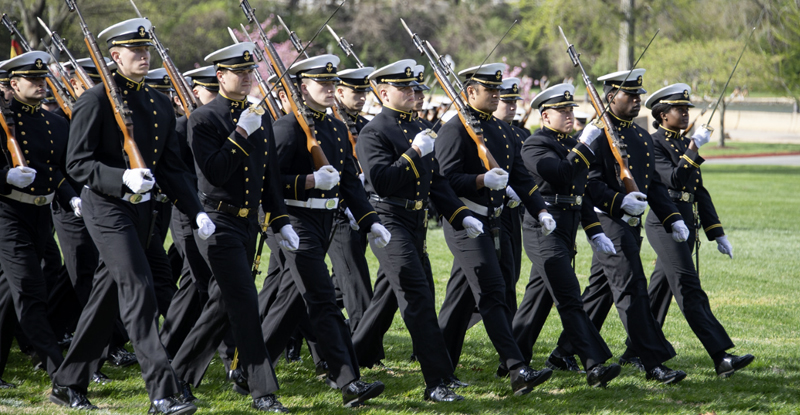By Lawrence Purdy, USNA ’68
Eliminating racial discrimination means eliminating all of it… [T]he Equal Protection Clause … applies without regard to any differences of race, of color, or of nationality—it is universal in [its] application… [T]he guarantee of equal protection cannot mean one thing when applied to one individual and something else when applied to a person of another color. If both are not accorded the same protection, then it is not equal.
—Students for Fair Admissions, Inc. v. President and Fellows of Harvard College, 600 U. S. 181, 206 (2023) (citations and punctuation omitted and edited).
Introduction
In Students for Fair Admissions, Inc. v. President and Fellows of Harvard College (“SFFA”),1 the United States Supreme Court revisited an issue that had been litigated before it twenty years earlier. In two separate cases brought against the University of Michigan,2 the issue was whether it was a violation of the Constitution and Title VI of the Civil Rights Act of 1964 for the university to use “race” as a factor in student admissions. On June 23, 2003, Justice Sandra Day O’Connor, writing for a 5-4 majority in Grutter v. Bollinger, declared that it was not.
As for “why” Justice O’Connor permitted the university’s pernicious use of race to continue, it clearly was not to remedy past discrimination by the university. Nor was it intended to remedy present discrimination experienced by individual minority applicants to the university. Indeed, the university claimed “only one justification for their use of race in the admissions process: obtaining the educational benefits that flow from a diverse student body.”3
For the past two decades, relying on Justice O’Connor’s deeply-flawed reasoning in Grutter schools across the country, including our service academies, have openly used race to benefit certain applicants and to racially discriminate against others.
Justice O’Connor’s opinion seemed to be driven entirely by ideological “virtue signaling” as opposed to being grounded in the words of the Constitution. Instead of adhering to the language of the Equal Protection Clause of the Fourteenth Amendment and the unambiguous language of Title VI of the Civil Rights Act of 1964, Justice O’Connor placed the Court’s imprimatur on a gauzy, ill-defined quest for “diversity” that, according to the University of Michigan, required it be permitted to use racially discriminatory policies in a seemingly endless effort to achieve it. Replaced were the Constitutional and legislative guarantees afforded every individual to be free from government sanctioned racial discrimination.
Perhaps the most disappointing aspect of Justice O’Connor’s ruling was this: After blindly ignoring the extensive and fully-supported trial court’s findings in the Law School case, Justice O’Connor proceeded to silently overrule the fundamental principle announced in Brown v. Bd. of Education (1954) perhaps the most powerful unanimous decision ever reached by any Supreme Court in our nation’s history.
Almost a half century before O’Connor put her pen to paper, nine white male Justices in Brown had unanimously ruled that “racial discrimination in public education is unconstitutional. All provisions of federal, state, or local law requiring or permitting such discrimination must yield to this principle.”4
Despite the abundant guidance in front of her, not a single word in Justice O’Connor’s opinion in Grutter was consistent with the Fourteenth Amendment, Title VI, or with Brown’s fundamental principle. Thankfully, her illegitimate rationale has been corrected by the Court in SFFA which effectively overruled Grutter. However, left unaddressed and unanswered in SFFA is the effect of the court’s decision on our nation’s service academies. The majority opinion phrased it this way:
The United States as amicus curiae contends that race-based admissions programs further compelling interests at our nation’s military academies. No military academy is a party to these cases . . . and none of the courts below addressed the propriety of race-based admissions systems in that context. This opinion also does not address the issue, in light of the potentially distinct interest that military academies may present.5
It did not take long for the battle to be joined by prospective applicants to West Point and Annapolis, respectively.6
A New Battle Joined
As a 1968 graduate of the United States Naval Academy who served as one of the pro bono lawyers representing the plaintiffs two decades ago in the Michigan cases, I had a renewed interest in one of the amicus curiae briefs filed in SFFA. The brief in question (“the SFFA retired officers’ brief”) supported the continuation of race-based admissions at Harvard and UNC.
It was joined by thirty-five senior military officials, thirty-three of whom were retired generals and admirals. On the list were three of my Naval Academy classmates: Navy Admiral Dennis Blair, Marine Corps Major General Charles Bolden, and Navy Admiral Michael Mullen.
The SFFA retired officers’ brief was essentially a reprise of a similar amicus brief filed in the Michigan litigation in 2003 (“the Gratz/Grutter retired officers’ brief”). After reading that brief which, back in 2003, both Admiral Blair and General Bolden had also joined, I was perplexed by my classmates’ stance.7 Why, I wondered, would these two honorable men be arguing against the use of a color-blind meritocratic system, one that forbade discrimination against every applicant based on his race?
Fast forward twenty years and I remain perplexed by their continuing support for these divisive policies. I had always assumed our compelling interest in having an effective military demanded that our military recruit and train the very best officers it could attract, irrespective of race.
Why, I wondered in 2003— and again in 2023—were my distinguished classmates urging that strict adherence to such a system would be seen as an impediment when it came to providing for the nation’s security?
Notwithstanding Justice O’Connor’s wayward deviation from the Constitution in her decision in Grutter, it’ was an argument that—from a military standpoint—made no sense two decades ago. And, of course, following the SFFA court’s discarding Justice O’Connor’s Grutter rationale, it makes even less sense today.
In SFFA, Harvard’s and UNC’s retired officer amici phrased the argument this way:
[The military must have the ability via race-conscious recruiting and admissions policies] to cultivate a diverse, highly qualified officer corps. That ability hinges on the military’s continuing admission of [racially] diverse student bodies into its service academies and continuing recruitment of [racially] diverse students into Reserve Officer Training Corps (“ROTC”) programs at civilian universities nationwide, such as [Harvard and UNC].8
The Supreme Court flatly rejected this proposition vis a vis Harvard and UNC. The question now becomes: What will the Court do if and when it is faced with the same issue in the context of our service academies? And what will Harvard’s and UNC’s military amici—including my (now three) distinguished classmates—have to say at that point?
Of course, one might hope they and their fellow amici in SFFA will carefully read the court’s opinion (along with Justice Clarence Thomas’s powerful concurrence) and urge our Department of Defense to obey the Supreme Court’s direction to renounce racial discrimination by, in fact, “eliminating all of it.”
Perhaps these senior retired officers will finally choose to embrace the words of Dr. Martin Luther King, Jr., who sixty years ago emphasized that the only thing that matters is the content of an individual’s character, not the color of his skin.
Or perhaps they will continue to support DoD’s current policies that ironically—even if unintentionally—mimic the old-time segregationists’ view that “race matters.”
Putting aside the constitutional, legislative, as well as the moral infirmities of their argument, the educational backgrounds of several of the individuals named in the SFFA retired officers’ brief stand in stark contrast to the argument that race preference admissions are needed in order to insure the “diversity of our military leadership.”
The first fact to consider is one set out by the government itself: Over 80 percent of today’s officer corps come from source institutions other than our service academies.9
Given that SFFA has specifically rejected the use of racial preferences to achieve “diversity” at civilian institutions hosting ROTC programs (such as Harvard and UNC), why, then, would it be permissible to use them at the service academies?
Secondly, the educational backgrounds of several of the senior officers who joined the SFFA retired officers’ brief10 demonstrate that one can achieve the highest level of leadership and success in the military without attending an “elite” school or a service academy where racial preferences are used to manipulate admissions. The senior officers who did not graduate from a service academy (or from Harvard) include:
Marine Corps General Joseph Dunford, a former Commandant of the Marine Corps and Chairman of the Joint Chiefs of Staff, is a 1977 graduate of St. Michaels College, Colchester, Vermont.
Army General James T. Hill is a 1968 graduate of Trinity University, San Antonio, Texas.
Navy Admiral Bobby Inman was a Tyler (Texas) Junior College graduate who eventually attended the University of Texas and graduated in 1950.
Air Force General John P. Jumper is a 1966 graduate of VMI who received his commission via ROTC.
Air Force General Lester L. Lyles, Jr., entered the Air Force via ROTC after graduating from Howard University, one of the nation’s preeminent Historically Black Colleges and Universities (“HBCUs”).
Navy Admiral William McRaven is a 1977 graduate of the University of Texas.
Air Force General Richard B. Myers, who also served as Chairman of the Joint Chiefs of Staff, is a 1965 Air Force ROTC graduate of Kansas State University, Manhattan, Kansas.
Air Force General Lori Robinson is a 1982 ROTC graduate of the University of New Hampshire, Durham, New Hampshire.
Army General Henry H. Shelton, another former Chairman of the Joint Chiefs of Staff, graduated from North Carolina State University and was commissioned via ROTC in 1963.
Air Force General Larry O. Spencer, a former Vice Chief of Staff, graduated from the University of Southern Illinois in 1979.
Army General Gordon R. Sullivan, a former Army Chief of Staff, graduated from Norwich University, Northfield, Vermont in 1959.
Army General Dennis L. Via graduated from HBCU Virginia State University in 1980.
Army General Darrell K. Williams graduated from HBCU Hampton Institute (now Hampton University), Hampton, Virginia in 1983.
General Johnnie E. Wilson began his Army career in the enlisted ranks and eventually graduated from the University of Nebraska-Omaha.
And, finally, former Navy SEAL and Medal of Honor winner, Senator Bob Kerrey, was a University of Nebraska-Lincoln Pharmacy School graduate in 1966. He entered the Navy via OCS in 1967.
Any suggestion that because of service academy educations, the remaining officers listed on the SFFA retired officers’ brief should somehow be judged superior to their non-service academy colleagues (many of whom, as shown above, graduated from less- or non-selective civilian institutions), would be contrary to the clear evidence.
It is also clear from all of us who knew him that General Bolden (one of a mere handful of black midshipmen who joined our class in the Summer of 1964) neither needed nor received a preference because of his skin color. Nor did he suffer the condescension—the “burden,” if you will—of classmates expressing concern that he had been evaluated against a lower standard to gain his appointment.
This burden is, in fact, poignantly described by a later graduate from the Naval Academy, Admiral Cecil D. Haney (USNA class of 1978). Admiral Haney, who disappointingly joined the military amici supporting race preference admissions at Harvard and UNC, wrote an open letter to USNA alumni in 2020 expressing his lingering discomfort that some of his Naval Academy classmates, and even some colleagues after he attained senior rank, attributed his admission to the Naval Academy—and his extraordinary advancement thereafter—to the use of race preferences.
“Even today as I enter a conference room,” Haney wrote, “I know that while most in the room have dignity and respect for all human beings, I suspect . . . there may be a small number that [are] in the same frame of mind as one of my midshipman classmates was in when in front of others (who did not challenge his beliefs), stated that I was only there because I was a part of some quota system. That comment continues to reverberate in my mind.”11
This is a patently undeserved burden for this thoroughly accomplished man to bear; but it is fully recognized as one of the adverse consequences every time the use of race is suspected, or known, to be part of an admissions (or military advancement) decision.
At any rate, Charlie Bolden surely was not admitted to meet any “quota” or “goal,” or to create some “critical mass” of underrepresented minority students at Annapolis in 1964, a time when lingering racism in many parts of our country clearly stood in the path of Bolden and many other minority applicants who sought to attend a service academy.
But this is not 1964. As I write, it is nearly 2024; and today I reject the false and condescending premise that minority individuals are prevented from, much less incapable of, fairly competing for a seat at our service academies.
Ending preferences at our service academies and at civilian colleges and universities need not result in declines in minority officers, much less declines in minority enrollments at the civilian schools that produce the bulk of our nation’s officer corps.12<
And surely no one is arguing that black or other minority applicants are incapable of excelling academically and in every other way necessary to compete with white and Asian applicants for an appointment to West Point, Annapolis, or the Air Force Academy. My Naval Academy classmate, General Bolden, is just one example.
The retired officers’ brief, beginning with the first iteration in Gratz and Grutter, also contained many perplexing assertions. One is the bizarre claim that students educated “in racially homogenous classrooms are ill-prepared for productive lives in our diverse society.”13 Though “homogenous” and “diverse” are never defined, the retired officers’ claim in Gratz and Grutter was, and remains, unfounded. We need look no further than to the undergraduate institutions attended by many of those who joined the retired officers’ brief in SFFA (described, above).
To be clear, no one is suggesting that racially homogeneous classrooms are more desirable than racially heterogeneous classrooms. But the retired officers’ implicit criticism of individuals who may have been educated in less racially diverse settings surely must have come as a surprise to the distinguished black generals whose names appeared on the first iteration of the retired officers’ brief in Gratz and Grutter.
Two of them, the late Army Lieutenant General Julius W. Becton, Jr. and Air Force General Lloyd W. Newton, graduated from racially homogeneous historically black universities, Prairie View A&M and Tennessee State, respectively.
In fact, several of the black generals who joined one or more of the “military briefs” in Gratz, Grutter, Fisher I, Fisher II, and SFFA, including my Naval Academy classmate, General Bolden, were educated in racially homogeneous settings.14
It’s a fair guess that many, if not most, of the retired white officers (including Admiral Blair) who joined these briefs beginning in 2003, up to and including the SFFA brief in 2023, had also been educated in what, today, might fairly be characterized as racially homogeneous classrooms. Yet to a man, each proved not to be, as the Gratz/Grutter retired officers’ brief contemptuously suggested, “ill prepared for productive lives in our diverse society.” Quite the opposite.15 Each rose to positions of unparalleled leadership in the United States military. The obvious lesson, as Dr. King taught us: the skin colors of those who surround us do not matter. Only their character does.
Apart from the obvious contradictions presented by the demographics and selectivity (or lack thereof) of the various civilian undergraduate institutions attended by the retired officers who appear on the SFFA brief (and on all its previous iterations), there remains the deeply troubling inference that only black officers can effectively lead black enlisted personnel. The incendiary corollary, of course, is that only white officers can effectively lead white enlisted personnel. This is an utterly divisive argument entirely at odds with the true meaning of military leadership.
Finally, I return to Annapolis and my 1968 classmates. Admirals Blair and Mullen, and General Bolden may not share the same skin color, but I am confident they share something far more important when it comes to the military’s mission. And that is a total dedication to our country and a willingness to put their lives on the line to protect the freedoms of each and every American—and the safety and well-being of every one of their shipmates and fellow Marines— without giving a passing thought to what anyone’s race or ethnicity may be.
That should be the only test for every officer entrusted with the duty of protecting our national security. It is for all these reasons that the practice of dividing ourselves along racial lines must stop.
Conclusion
As I observed over twenty years ago, if we have learned nothing else from our tragic history with race, we should have learned this: dividing any collection of individuals by race—whether it be a platoon, a battalion, a brigade, or an entire nation—and assigning benefits or assessing penalties to the resulting groups, is fundamentally destructive.
Perpetuating racial favoritism, and its opposite, racial discrimination, doesn’t heal a society; it poisons it.
Policies that focus on race don’t lead to a cohesive and effective military; they undermine it.
For the sake of our national security, our service academies’ race-based admissions policies should be ended.
The decision in SFFA is a good, if incomplete, start. For the courts eventually to reach the same result in the currently-pending lawsuits against West Point and Annapolis would complete the task.
__
Lawrence Purdy is a 1968 graduate of the United States Naval Academy; larry.purdy@protonmail.com. After completing his military service commitment (which included a year-long tour in Vietnam), he graduated in 1977 from William Mitchell College of Law in St. Paul, Minnesota. While in private practice in Minneapolis, Minnesota, he served as part of the pro bono trial and appellate team representing the plaintiffs in Gratz v. Bollinger, 539 U. S. 244 (2003) and Grutter v. Bollinger, 539 U. S. 306 (2003). He has been a guest lecturer at colleges and universities across the country and is the author of several law review articles and essays on the topic of race. He last appeared in AQ in the winter of 2021 with, “On Dubious Race Preferences,” a review of Gail Heriot’s A Dubious Expediency: How Race Preferences Damage Higher Education (2021).
First published on National Association of Scholars / Academic Questions publication, Winter 2023
Footnotes
1 Students for Fair Admissions, Inc, v. President and Fellows of Harvard College, 600 U. S. 181 (2023). The court’s decision jointly addressed different race-based systems at Harvard and the University of North Carolina and reached the conclusion that both violated the Equal Protection Clause of the Fourteenth Amendment. Id., at 213.
2 Gratz, et al. v. Bollinger, 539 U. S. 244 (2003) (the “undergraduate” case)[2] and Grutter v. Bollinger, 539 U. S. 306 (2003) (the “Law School” case).
3 Grutter, supra note 2, 539 U. S., at 328.
4 Brown v. Bd. of Educ. (“Brown II”), 349 U. S. 294, 298 (1955) (emphasis added).
5 SFFA, supra note 1, 600 U. S., at 213, footnote 4.
6 See, Students for Fair Admissions v. The United States Military Academy at West Point, et al. (Case 7-23-cv-08262) (USDC, S.D.N.Y. (White Plains Div.)) (09-19-2023) (“West Point”); and Students for Fair Admissions v. The United States Naval Academy, et al. (Case 1:23-cv-02699-ABA) (USDC, D. Maryland (Northern Div.)) (10-05-23) (“Annapolis”).
7 See the author’s personal response to the 2003 “retired officers’ amicus brief”: R. Lawrence Purdy, “Operation Racial Preferences: What the U. S. military doesn’t need,” National Review Online, May 28, 2003.
8 Br. of Charles S. Abbot, et al. as Amici Curiae 1-2, and 31.
9 Br. of United States as Amicus Curiae Supporting Respondent 16, 18.
10 Educational descriptions of non-service academy graduates were researched based on the list of names provided in the Br. of Charles S. Abbot, et al. as Amici Curiae (Appendix—Abbreviated Biographies of Amici Curiae).
11 See Haney letter at: https://www.usna.com/news20-call-to-action.
12 See, SFFA, supra note 1, 600 U. S., at 229, n. 9: “Three out of every five American universities do not consider race in their admissions decisions. See Brief for Respondent in No. 20-1199, 40. And several States—including some of the most populous (California, Florida, and Michigan)—have prohibited race-based admissions outright.” See Brief for Oklahoma et al. as Amici Curiae 9, n. 6) (emphasis in original).
13 Consol. Br. of Julius W. Becton, Jr., et al. as Amici Curiae [in Gratz and Grutter] 8.
14 It appeared that less than 1% of USNA’s class of 1968 was made up of black midshipmen.
15 Among the virtually all white class of 1968 were scores of extraordinary future military and civilian leaders including former United States Senator Jim Webb (D-Virginia). While serving on active duty as a Marine Corps infantry officer in Vietnam, Webb was awarded the Navy Cross, the Silver Star, two Bronze Stars, plus two Purple Hearts. The injuries he suffered during combat resulted in his being medically retired from the Marine Corps. Thereafter, he served as the Secretary of the Navy in the Reagan Administration before later winning a seat in 2006 in the United States Senate. In 2020, Mr. Webb was named the first distinguished fellow of University of Notre Dame’s International Security Center.








Leave a Comment